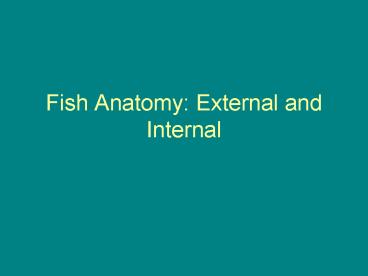Fish Anatomy: External and Internal PowerPoint PPT Presentation
1 / 21
Title: Fish Anatomy: External and Internal
1
Fish Anatomy External and Internal
2
Outline
- General review of fishes
- External anatomy
- How to key out fish using external
characteristics - Internal anatomy
- What well look for during dissections
- What youll write for your fish paper
3
Jawless Fish
- Lampreys and hagfishes
- Primitive
- No jaws suctorial mouth
- No paired fins
- No scales
- Hagfish
- Blind
- Scavengers
- Lampreys
- Parasitic attach to hosts and suck body fluids
4
Jawless Fish Anatomy
5
Cartilaginous Fish
- Skeleton made of cartilage
- Well-developed lower jaw
- Males have claspers for internal fertilization
- Placoid scales (skin feels like sandpaper)
- Paired and unpaired fins
- Includes sharks, skates, rays, and chimaeras
6
Shark Anatomy
7
Bony Fish
- Skeleton made at least partially of bone
- Dorsal, anal, and caudal fins
- Paired pectoral and pelvic fins
- Bony gill cover (operculum)
- Lateral line (vibration detection)
- Cycloid (smooth) or ctenoid (spiny) scales
- Swim bladders
- Variety of shapes
8
Bony Fish Anatomy
9
Comparison of Scales
10
How to Key Out (Identify) Fish
- Sequenced observations of key characters like a
Choose Your Own Adventure book - Dichotomous taxonomic key at each step of the
Choose Your Own Adventure, you never have more
than two choices - Start with general characteristics, and progress
to finer characteristics
11
Examples of Characters
- Anal soft rays
- Gill rakers on first gill arch
- Scales along lateral line
- Pelvic fins present or absent, thoracic (chest
area) or abdominal (belly area) - Percent of head or eye diameter of standard
length - How many dorsal fins? What are they made out of?
12
(No Transcript)
13
(No Transcript)
14
(No Transcript)
15
Example of Character List
16
Fish Internal Anatomy
- Two-chambered heart and gills circulation, gas
exchange - Stomach / intestine / liver digestion, breakdown
of macromolecules into molecules the fish can use
for growth, energy, etc. - Swim bladder buoyancy
- Red muscle slow twitch, holds lots of oxygen,
endurance swimming - White muscle fast twitch, holds little oxygen,
fast bursts of swimming
17
Things to Look For During Dissections
- Operculum
- Type of scales
- Lateral Line
- Countershading
- Internal organs
- Swim bladder
- Red and white muscle
- Body and tail shape (how do these affect
swimming?) - Mouth shape (how does this affect feeding?)
- Gill area in relation to activity level of fish
18
Fish Writing Assignment
- Page 48 in your reader
- Pick two fish. Write 2 pages about the feeding
strategy of one, and the locomotion strategy of
the other - Can use the Internet, cite all sources
- Be careful not to plagiarize easy to do with
this assignment! - Include a picture of each of your fish
- Be as detailed as possible, but make sure you
understand what youre writing
19
Fish Body Forms
20
Fish Mouth Parts
21
Fish Tails

